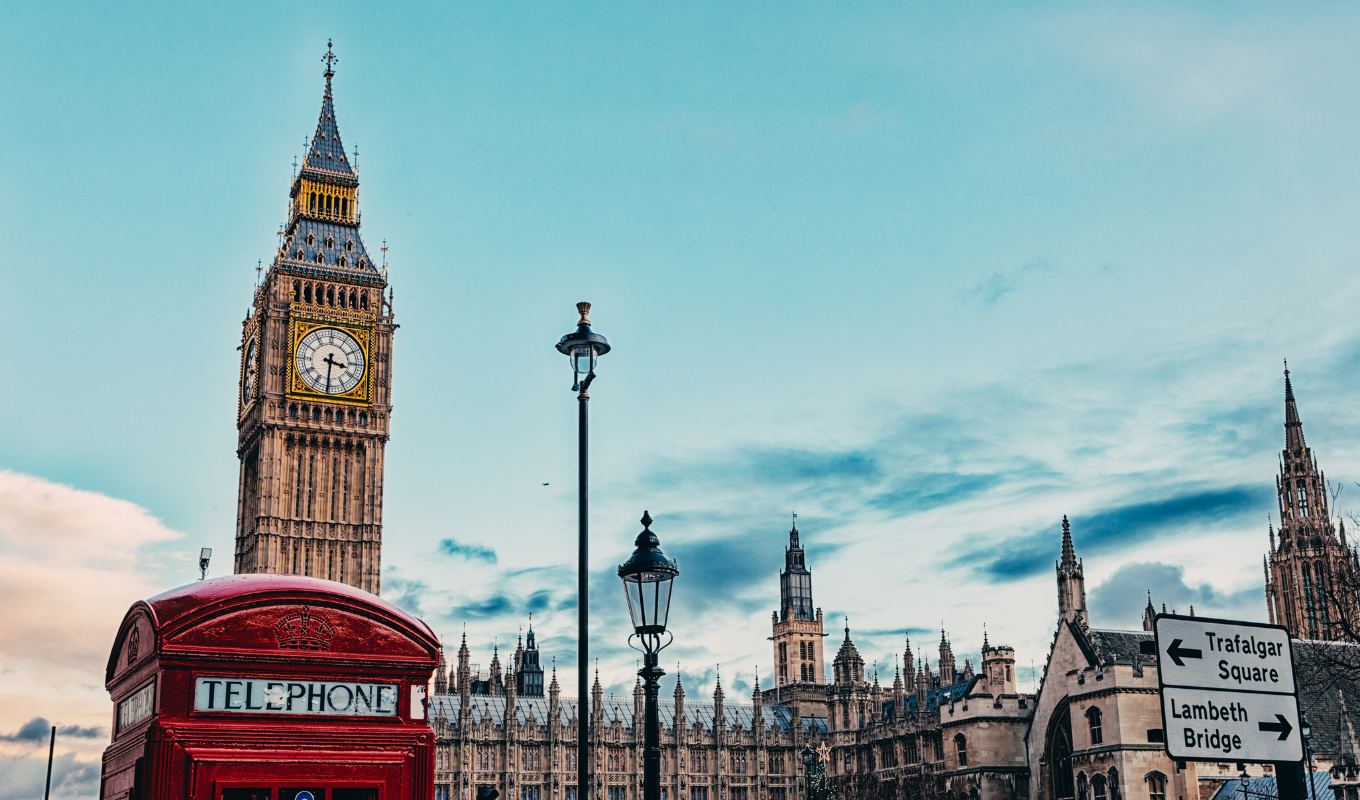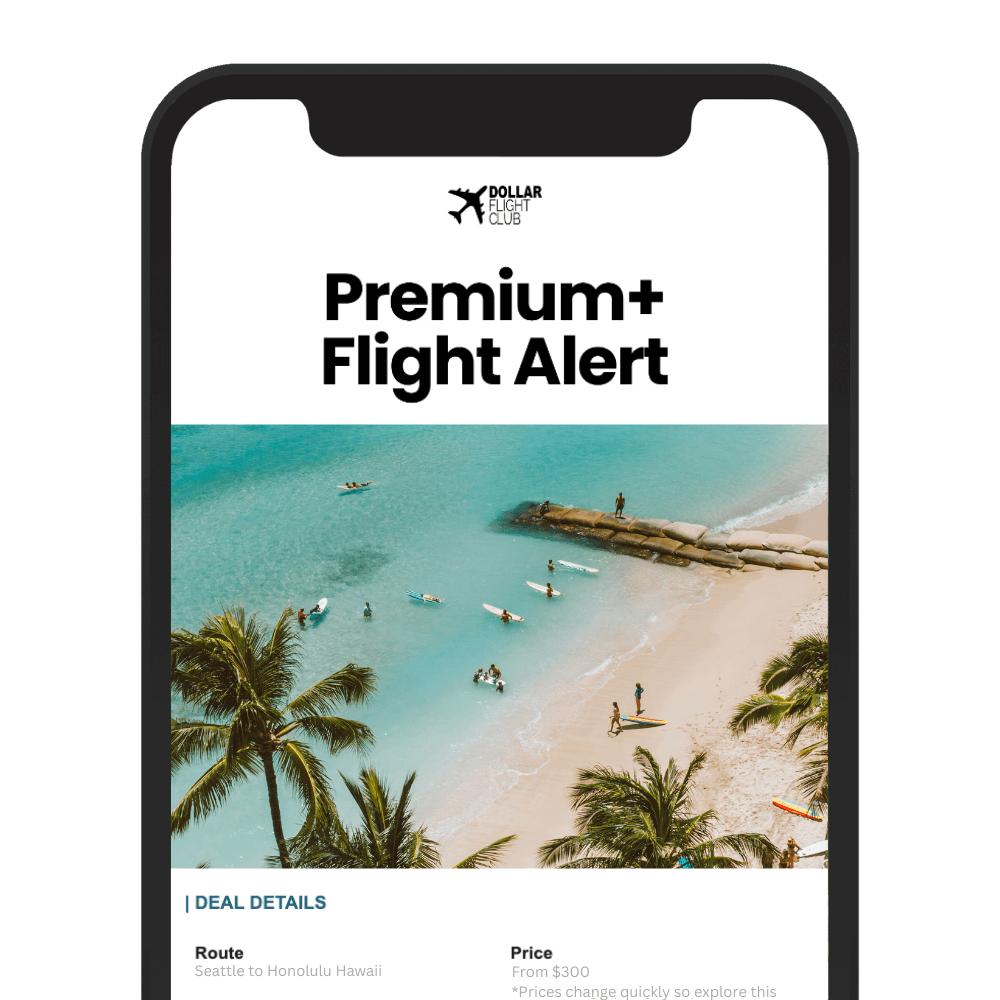London is a blend of rich history and modern energy, making it a top destination for millions of travelers each year. Here’s a quick guide to help you plan your visit:
- Best Time to Visit: Spring (March–May) and early Autumn (September–October) offer pleasant weather, smaller crowds, and reasonable prices. Summer is busier, while winter is quieter and more budget-friendly.
- Budget: Plan for about $130/day per person (excluding flights), balancing free activities like museums with paid attractions.
- Getting Around: Use the Tube, buses, or walk to explore the city. Contactless payments and Oyster cards make public transport easy.
- Top Attractions: Buckingham Palace, Westminster Abbey, Tower of London, London Eye, and British Museum are must-sees.
- Where to Stay: Central neighborhoods like Covent Garden or South Bank are convenient but pricier. Outer zones offer cheaper options with good transport links.
- Food: Try a full English breakfast, Sunday roast, fish and chips, or afternoon tea. Borough Market is great for diverse dining options.
- Tips: Pack layers for unpredictable weather, book flights and accommodations early, and avoid peak travel times like school holidays.
Whether you’re into iconic landmarks, vibrant neighborhoods, or amazing food, London has it all. Start planning early to make the most of your trip!
When to Visit London
London is a city that welcomes visitors all year, thanks to its mild climate. Each season brings its own perks and challenges, so timing your trip can make a big difference.
Weather by Season
Spring (March–May) marks the city’s awakening from winter. Temperatures gradually climb from 50°F (10°C) in March to 61°F (16°C) by May. It’s also when London’s royal parks come alive with blooming flowers, creating stunning cityscapes.
Summer (June–August) brings the warmest weather, with July averaging 75°F (24°C). However, this is also the busiest time, with packed public transport and tourist hotspots.
Autumn (September–November) sees temperatures cooling from 64°F (18°C) to 50°F (10°C). October and November tend to be rainy, with over 65 mm of rainfall. Despite the increased rain, autumn offers a quieter, more relaxed atmosphere with comfortable weather.
Winter (December–February) brings cold and damp days, with average temperatures around 43°F (6°C). January is particularly rainy, with about 11.53 days of precipitation.
London’s weather may be unpredictable, but its year-round events calendar ensures there’s always something exciting happening.
Annual Events and Festivals
London’s vibrant events and festivals can shape your travel experience. Summer events like Wimbledon and the Notting Hill Carnival draw massive crowds, with the latter attracting over a million visitors in August. These events can push up hotel prices and make the city feel busier.
The Christmas season transforms London into a festive wonderland with markets, ice rinks, and dazzling holiday displays. While this magical time is unforgettable, it also comes with higher hotel rates and packed attractions. On the other hand, spring and autumn festivals offer cultural experiences with fewer crowds, making them ideal for those looking to explore at a more relaxed pace.
Choosing Your Travel Dates
For a balanced experience, the shoulder seasons of April–May and September–October are often the best times to visit. These months usually offer pleasant weather, manageable crowds, and reasonable prices. Budget-conscious travelers might consider January or even August, as both months often have discounted flights and accommodations.
To avoid peak crowds, steer clear of school holidays, including Easter, late July to early September, and half-term breaks in February, May, and October. If you’re visiting in summer, book accommodations and tours well in advance. For winter trips, you might find great last-minute deals. No matter when you visit, pack layers and waterproof clothing – London’s weather is famously unpredictable.
Ultimately, your ideal travel dates depend on your priorities. If warm weather and lively crowds are your thing, summer is your season. For a blend of cultural highlights and fewer visitors, spring and autumn are excellent choices. And if you’re after a more local, budget-friendly experience, winter might be just the ticket – though you’ll need to trade some sunshine for savings.
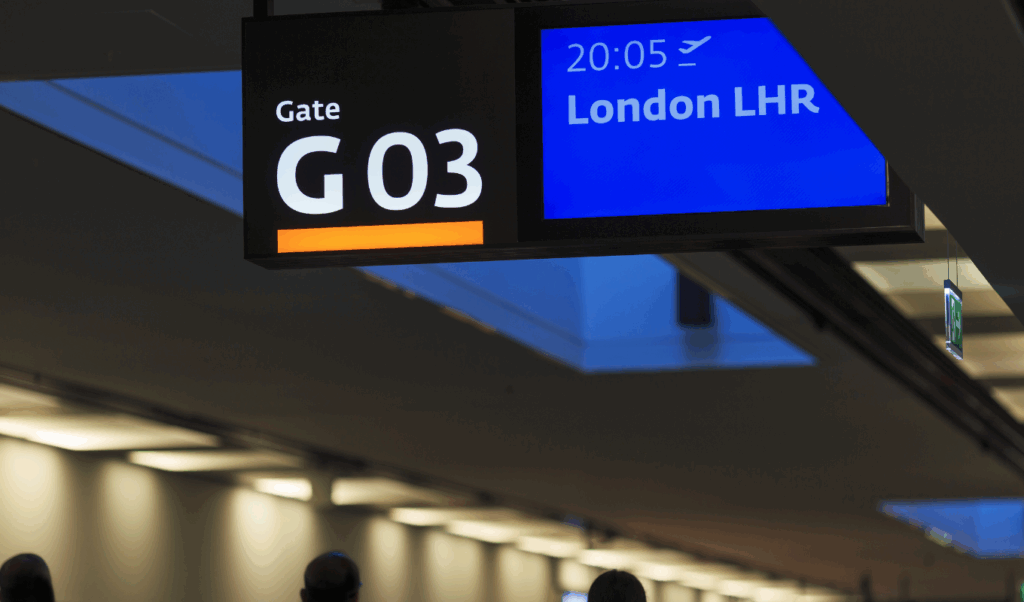
Getting to London
London is well-connected to the U.S., with six international airports offering frequent flights from major cities. Picking the right airport and planning your transfers ahead of time can help you save both time and money on your trip.
London Airports
If you’re flying from the U.S., Heathrow Airport is a popular choice, particularly for travelers from the East Coast. Just 14 miles from central London, Heathrow is Europe’s busiest airport, handling nearly 80 million passengers in 2023. Its route from New York JFK alone saw over three million passengers.
Gatwick Airport, London’s second-largest, is located 33 miles from the city center. In the first half of 2023, Gatwick served nearly 19 million passengers and offers flights to about ten U.S. destinations. It’s often a cheaper alternative to Heathrow, so it’s worth comparing fares.
The other airports – Stansted (40 miles from central London), Luton (29 miles), London City (the closest but with limited routes), and Southend (40 miles) – primarily cater to European and budget carriers. For U.S. travelers, Heathrow and Gatwick remain the most convenient options.
The next step? Figuring out how to get from these airports to central London.
Airport to City Transport
London offers a variety of transport options from its airports, including rail, Tube, and coach services. Booking in advance often results in the best prices.
- Heathrow: The Heathrow Express is the fastest option, reaching Paddington in 15 minutes. Advance fares start at $6.90, but peak prices can go up to $31.25. The Elizabeth Line provides a more affordable alternative at $16, while the Tube is the cheapest at $7.25 to Zone 1 using Oyster or contactless payments. Coach services start at $7.50.
- Gatwick: The Gatwick Express takes you to London Victoria in 30 minutes, with advance tickets starting at $26.25. Budget-friendly coach services are available from $6.50.
- Stansted: The Stansted Express connects to London Liverpool Street in 47 minutes. Advance tickets cost $12.15, while same-day fares are about $29.90. EasyBus coaches can be as cheap as $2.50 with early bookings.
- Luton: A shuttle to Luton Airport Parkway links to trains heading to central London, with off-peak fares starting at $16.25. National Express coaches offer rides from $6.25.
- London City Airport: The Docklands Light Railway (DLR) provides a direct route to central London for $4.75 during peak hours.
For the lowest prices, book your transfers early and use Oyster or contactless cards for Tube and DLR rides.
Finding Cheap Flights
Once your airport transfers are sorted, focus on scoring affordable airfare. Services like Dollar Flight Club can help by sending alerts for deals that can slash up to 90% off regular prices. They track fare changes and notify members about standout offers.
Plan to start your search 4–6 months ahead, especially if you’re traveling during spring, summer, or fall. Use tools like Google Flights, Kayak, Expedia, and Momondo to compare options. Flexibility is your best friend – check fares for both Heathrow and Gatwick, consider one-way versus round-trip tickets, and aim for departures on less popular days like Tuesdays, Wednesdays, or Saturdays.
Set up price alerts and search in incognito mode to avoid dynamic pricing. Remember, U.S. airlines allow free cancellations within 24 hours of booking, giving you added flexibility. Budget airlines can offer extra savings, but watch out for added fees for baggage, seat selection, or refreshments. With airfare up 12% in January 2025 compared to the previous year, staying proactive and flexible is more important than ever.
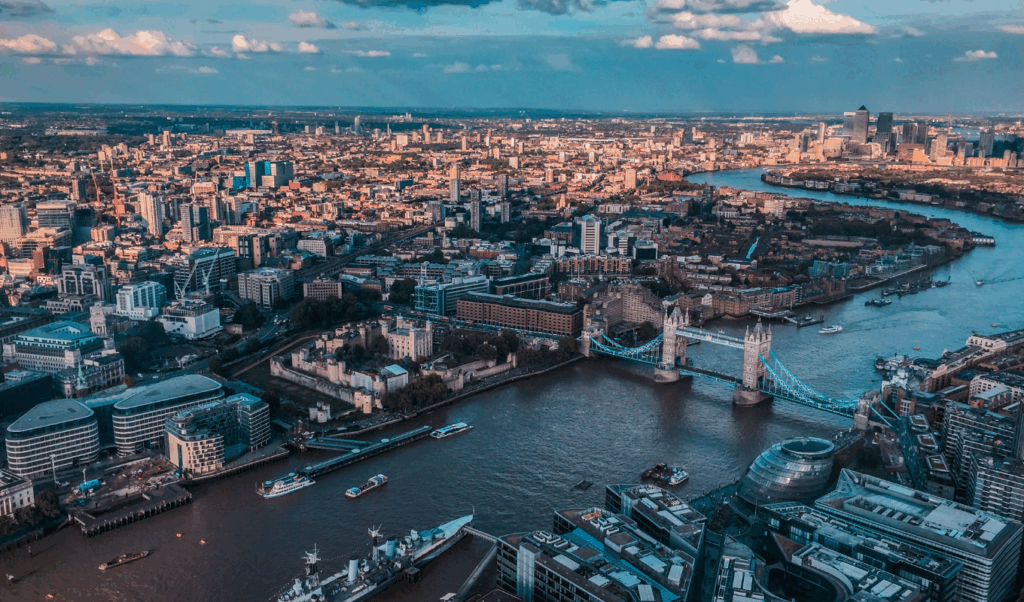
Where to Stay in London
London offers a wide range of accommodations, from budget-friendly hostels to luxury hotels. On average, a central double room costs around $411 per night. Finding the right place means balancing comfort, location, and price.
Best Areas for Tourists
Central London is perfect for first-time visitors, thanks to its proximity to major attractions and excellent public transport. Each neighborhood has its own charm, so here are some great options to consider:
- Covent Garden: This lively area is packed with street performers, boutique shops, and diverse restaurants. Its central location makes it convenient, though prices and crowds can reflect its popularity.
- South Bank and Southwark: These neighborhoods offer great value and are close to iconic landmarks like the London Eye, Tate Modern, and Borough Market. They’re slightly less tourist-heavy but still well-connected.
- Kensington: Known for its upscale vibe, this area boasts elegant streets, Hyde Park, and top-tier museums like the Natural History Museum and Victoria and Albert Museum. Expect higher prices for the refined surroundings.
- The City of London: Ideal for business travelers or those seeking excellent transport links. Attractions like St. Paul’s Cathedral and the Tower of London are nearby, though the area tends to quiet down on weekends.
- Shoreditch: A hotspot for younger visitors, Shoreditch is known for its trendy eateries, vintage shops, and bustling nightlife. While it’s a bit farther from traditional tourist sites, it offers a glimpse into London’s modern cultural vibe.
Types of Accommodation
Once you’ve chosen a neighborhood, you’ll find plenty of options to suit your style and budget:
- Hotels: A classic choice, hotels offer conveniences like daily housekeeping and concierge services. Budget options, like The Z Hotel Trafalgar, start at around $150 per night. Mid-range hotels such as Page8 Hotel near Trafalgar Square range from $200 to $300 per night, while luxury properties can exceed $500 per night.
- Vacation Rentals: Perfect for travelers who want more space or cooking facilities. A one-bedroom rental in central London typically costs between $180 and $400 per night.
- Serviced Apartments: These combine hotel-like services with the comforts of home. Prices range from $70 per night for budget options to $220–$480 per night for upscale stays.
- Hostels: The most affordable option, with shared rooms costing as little as $110 per week. Private hostel rooms generally range from $80 to $120 per night, and many include breakfast and communal spaces.
- HomeExchange: For those open to swapping homes, a one-year subscription costs about $235.
Booking Tips
Timing is everything when it comes to securing the best deals. Hotel prices fluctuate depending on the season and day, so booking at least seven days in advance is wise. Traveling during quieter months like August and September can also help you save.
Be aware that many quoted prices don’t include VAT, which adds 20% to your bill. Always check whether taxes are included to avoid surprises.
Staying outside Zone 1 can significantly cut costs while still keeping you connected to central London via the Tube. Reading recent reviews can also help you avoid issues like noise or maintenance problems.
With a bit of planning and flexibility, you can find accommodations that suit your needs and budget in this vibrant city. Next, let’s dive into how to navigate London effortlessly during your visit.
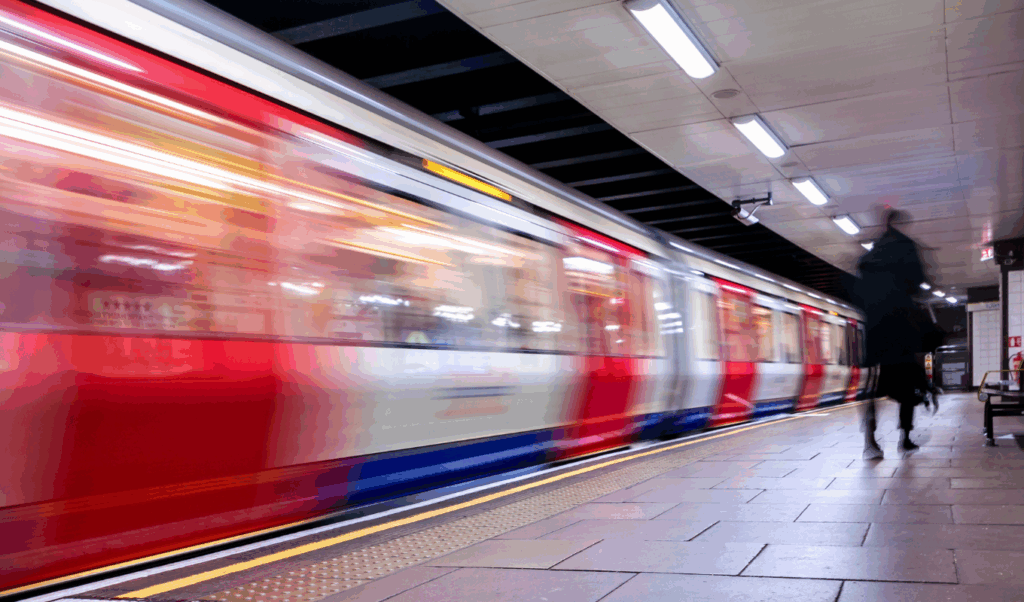
Getting Around London
Once you’ve settled into your London accommodation, getting around the city is a breeze thanks to its variety of transport options. London’s extensive network, which includes the Tube, buses, Overground, DLR, trams, and river boats, ensures you can easily reach almost any destination. In fact, the city’s transport system serves over a billion Underground passengers each year.
Public Transport System
The London Underground, commonly known as the “Tube”, is the backbone of the city’s transport system. With 270 stations spread across 11 lines, it’s often the quickest way to navigate central London. An adult off-peak fare within Zone 1 costs $3.35 (£2.70), while peak hours – 8:30–9:30 AM and 5:30–6:30 PM on weekdays – may cost slightly more.
If you prefer a more scenic route, London’s buses are a great option, accommodating over two billion journeys annually. The fare for Oyster card users is fixed at $2.17 (£1.75), regardless of distance, with a daily cap of $6.51 (£5.25). Plus, the “Hopper” fare allows unlimited bus rides within one hour of your first tap-in.
To pay for public transport, use a contactless card or an Oyster card – just tap in and out to register your fare. For planning trips, the TfL Journey Planner is an excellent tool to find the fastest routes. And if your destination is less than two Tube stops away, walking might be faster and, of course, free.
For shorter trips, walking and cycling are also fantastic options in London.
Walking and Cycling
Central London is compact and highly walkable, with many attractions located close to one another. For those who enjoy cycling, the city offers well-planned infrastructure, including Cycleways for efficient travel through busy areas and Quietways for more relaxed routes.
Santander Cycles, London’s bike-sharing program, makes short-term rentals simple and affordable. As of March 2023, the system includes over 12,000 bikes and 800 docking stations across central London and nearby areas. A 24-hour access pass costs $2.05 (£1.65) and includes 30 minutes of ride time, with additional charges for longer rides. Bikes can be rented via the official app or directly at docking stations.
Some popular cycling routes include the Thames Path and the Regent’s Canal Towpath. For a more scenic experience, try the Richmond Park Loop, where you might spot roaming deer, or head to the Epping Forest Trails for off-road cycling adventures.
Whether walking or cycling, tools like the TfL Journey Planner or apps such as Komoot, Strava, and Citymapper can help you map out your route. Remember to wear a helmet, use lights at night, and signal clearly. TfL also offers Cycle Skills courses, which include discounts on safety gear.
Taxis and Rideshares
If public transport or active travel isn’t your preference, private transport options are widely available. Black cabs are the most iconic choice, with drivers renowned for their deep knowledge of London streets. However, they are also the priciest option, with minimum fares set to increase to $5.21 (£4.20) in April 2025.
Ride-hailing apps like Uber and Bolt provide a convenient alternative. For instance, Uber charges a base fare of $2.61 (£2.10) with a minimum fare of $5.34 (£4.30). Rates include $1.44 per mile and $0.16 per minute, plus a $4.99 operating fee. Pre-booked minicabs are another option, often offering fixed rates without surge pricing. For airport transfers, minicabs typically cost 15–20% less than black cabs.
Here’s a quick comparison of fares from Heathrow to Central London:
| Option | Off-Peak Fare | Peak Fare |
|---|---|---|
| Black Cab | $112–$124 | $124–$136 |
| Pre-booked Minicab | $93–$112 | $93–$112 |
| Ride-hailing App | $81–$118 | $81–$118 (plus surge) |
Stick with licensed services for safety and reliability.
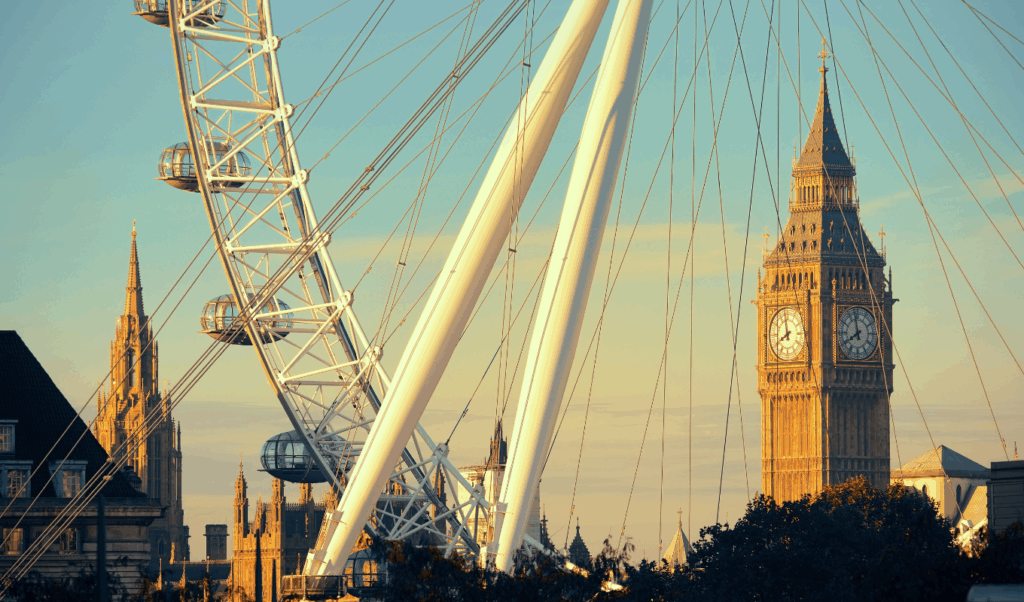
What to Do, See, and Eat in London
Once you’ve got navigating London down, it’s time to dive into its legendary landmarks and incredible food scene. A city steeped in history and buzzing with energy, London offers something for everyone. Plan to spend 3–5 days soaking in the sights and embracing the atmosphere.
Famous Landmarks and Attractions
Start with Buckingham Palace, where the Changing of the Guard ceremony is a must-see. Just a short walk away, Westminster Abbey (tickets from around $37.25/£30.00) is packed with history, from royal weddings to coronations. Nearby, the Houses of Parliament and Big Ben create one of the city’s most iconic views.
For a deeper dive into history, visit the Tower of London (entry from about $44.48/£35.80), home to the Crown Jewels and centuries of fascinating stories. Right next to it, Tower Bridge offers stunning views and a glass floor that lets you look straight down onto the Thames. If city panoramas are your thing, the London Eye (tickets from approximately $44.70/£36.00) is a must – especially at sunset when the city lights come alive. History and art lovers should not miss the British Museum, where treasures like the Rosetta Stone and Egyptian mummies await.
Another architectural gem is St. Paul’s Cathedral (entry from around $32.25/£26.00). Designed by Christopher Wren, it features a dome with breathtaking views of the city. For a different kind of entertainment, head to the West End for world-class theater – just be sure to secure tickets ahead of time. And if you’re curious about royal secrets, a Royal Walking Tour (starting at about $18.63/£15.00) is a great way to uncover hidden stories about the monarchy.
When you’re ready to venture beyond the city, there are plenty of unforgettable day trips and unique experiences to enjoy.
Special Experiences and Day Trips
London’s surroundings are just as captivating. A visit to Windsor Castle, the oldest and largest occupied castle in the world, offers a peek into royal life. Or, take a trip to Stonehenge, which has stood on the Salisbury Plains for roughly 5,000 years, shrouded in mystery.
For picturesque countryside, the Cotswolds is unbeatable. Spanning nearly 800 square miles, its charming villages and rolling hills are perfect for a Villages of The Cotswolds Small Group Tour (around $160.23/£129.00). Harry Potter fans won’t want to miss the Warner Bros. Studio Tour, where you can immerse yourself in the wizarding world with authentic sets and props.
Historic cities like Bath, with its Roman roots and Georgian architecture, or Oxford and Cambridge, known for their prestigious universities, are also worth exploring. For a more leisurely experience, hop on a Thames River cruise. Evening cruises (starting at about $60.87/£49.00) showcase the city’s illuminated landmarks, while daytime cruises are perfect for snapping photos of Tower Bridge, the London Eye, and Parliament.
Food and Drink
After all that exploring, dive into London’s incredible food scene. British cuisine here goes far beyond the basics, offering both classic comfort and inventive modern twists. Start your day with a full English breakfast at spots like 338 Cafe in Bethnal Green or Caravan in King’s Cross. For a fresh take on British dishes, try Dishoom.
A Sunday roast is a must-try tradition. Places like The Pig & Butcher, Blacklock, Temper, and Hawksmoor serve up hearty roasts complete with Yorkshire pudding and seasonal veggies. For fish and chips, head to Poppies or check out traditional pubs near Charing Cross and London Bridge. Craving pie and mash? Goodards in Greenwich offers a classic version, while Holborn Dining Room adds an upscale twist.
For a quintessentially British experience, indulge in afternoon tea at iconic venues like The Savoy or Fortnum & Mason. Think finger sandwiches, scones with clotted cream, and delicate pastries served on elegant china. Food lovers should also stop by Borough Market, where you’ll find everything from artisanal cheeses to fresh produce.
For a taste of history, dine at Rules, the city’s oldest restaurant, established in 1798, or Wiltons, which has been serving traditional British fare since 1742.
From royal landmarks to countryside escapes and unforgettable meals, London delivers an experience that will leave you eager to plan your next visit before you’ve even left.

Practical Tips and Local Information
Planning your London trip is just the beginning – knowing how to navigate the city like a local can make all the difference. From managing your money to understanding local customs and preparing for the ever-changing weather, these tips will help you avoid common missteps and enjoy a smoother stay.
Money and Payments
To save yourself from unnecessary fees and hassles, use a credit card that doesn’t charge foreign transaction fees. Before you travel, inform your card provider about your trip and ensure you know your PIN, as chip-and-PIN terminals are standard in London, while chip-and-signature cards are rare.
When paying, always opt for British pounds. Dynamic Currency Conversion (DCC) might sound convenient, but it often comes with poor exchange rates that can cost you more. At ATMs, decline any offered conversion and choose to be charged in pounds instead. Keep in mind that foreign transaction fees typically range from 2% to 5% of the purchase amount.
Contactless payment is the norm in London, with most places accepting tap cards. However, it’s still a good idea to carry a small amount of cash, as some machines, like those on public transport, may only take coins. Using ATMs generally offers better exchange rates than currency exchange kiosks.
Once your finances are sorted, understanding local customs will help you blend in and stay safe.
Safety and Local Customs
London is a relatively safe city, but staying alert is key. Keep your belongings secure, especially in crowded places or on public transport. Plan your routes ahead of time and stick to well-lit areas, particularly at night.
In emergencies, dial 999 or 112 for police, ambulance, or fire services. Use 101 for non-urgent matters. If you see any unattended bags or suspicious items, report them immediately. When traveling at night, stick to licensed taxis or pre-booked minicabs, and avoid walking alone in unfamiliar areas.
Politeness is a hallmark of British culture. Always say “please” and “thank you”, and respect the unwritten rule of queuing. On escalators, stand on the right to let others pass.
Be cautious of pickpockets, particularly in busy areas. Remember that traffic drives on the left, so look both ways carefully when crossing streets. At ATMs, shield the keypad and keep your wallet or purse close.
Packing and Preparation
London’s weather is famously unpredictable, so layering is your best friend. Check the forecast a day or two before your trip to plan your outfits. Stick to versatile, neutral clothing that works for both casual exploring and slightly dressier occasions.
Comfortable walking shoes are a must – they’ll keep you going through long days of sightseeing and can transition easily to evening plans. Waterproof footwear is a smart choice year-round, along with a compact, sturdy umbrella or a waterproof jacket with a hood.
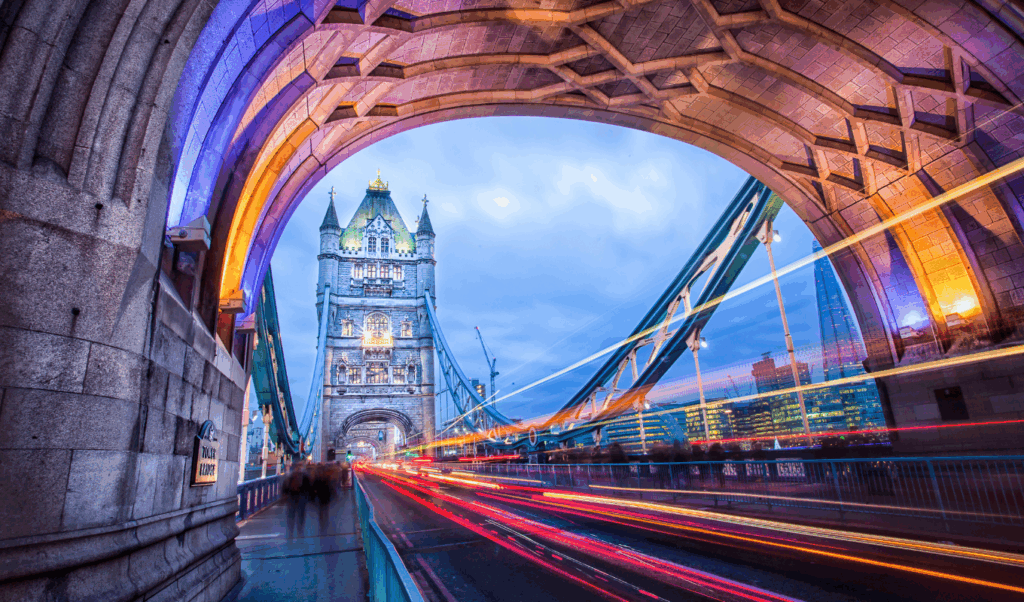
Start Planning Your London Trip
London is a city that rewards thoughtful preparation, so having a clear plan in place can make all the difference. Start by mapping out a four- to five-day itinerary, which gives you enough time to enjoy the major sights without feeling rushed. Aim to visit 2–3 key attractions each day, leaving room for spontaneous discoveries along the way. Adding some walking routes to your schedule is a great way to link nearby landmarks and soak in the city’s charm.
When it comes to accommodations, booking early is key, especially if you want to stay in central London. If you’re looking to save, consider staying in outer zones where prices are lower. A one-day travelcard for zones 1–3 costs under $12, making transportation affordable even if you’re staying farther out. Also, don’t forget to download offline maps via Google Maps before your trip – this will make navigating the city much easier.
Efficient transport planning can save both time and money. The London TFL app is a must-have for real-time updates on public transport. If you’re planning to explore beyond London, a BritRail Card can help you save on train fares. Keep in mind that London operates largely cash-free, so ensure your credit or debit cards are set up for international use and check for any foreign transaction fees.
Seasonal planning can also enhance your experience. Spring offers mild weather and blooming flowers, while summer is perfect for outdoor activities – though you’ll encounter larger crowds. Winter, on the other hand, brings fewer tourists and lower costs, but you’ll need to pack warm clothing.
For flights, consider using Dollar Flight Club alerts, which can help you snag deals with savings of up to 90% on both economy and premium tickets.
Budgeting is another crucial part of planning. Mix paid attractions with free activities to keep costs down. Many of London’s top museums don’t charge an entry fee, and the London Pass can provide discounted access to multiple landmarks if you plan to visit several in one trip. Affordable dining options include street food markets and supermarket meal deals, which cost around $6.50. While the average daily cost per person is approximately $130, smart planning can help you stretch your budget further. Booking attractions online often results in better prices, and discount websites like Groupon can offer deals on activities and dining.
With its rich blend of history, modernity, and culture, London has something for everyone. A well-thought-out plan ensures you can enjoy the city’s highlights without overspending.
FAQs
What are the best ways to find affordable places to stay in central London?
Finding a place to stay in central London without stretching your budget is totally doable with a bit of planning. Budget-friendly hotel chains like Premier Inn, Travelodge, and Ibis are great options – they offer comfortable rooms at reasonable prices. Booking early is another savvy move, especially in areas like Bloomsbury or Covent Garden. These neighborhoods put you right in the heart of the action without costing a fortune.
To save even more, think about visiting during off-peak seasons when rates are typically lower. Use reliable booking platforms to compare prices, and if your schedule allows, stay flexible with your travel dates to grab the best deals. With some smart planning, you can enjoy a cozy stay in central London without blowing your budget.
What’s the best way to navigate London’s public transportation as a first-time visitor?
If you’re looking for an easy way to navigate London, consider using a Visitor Oyster card or a contactless payment method like your credit or debit card. These options let you pay as you go and are often more affordable than buying individual tickets. The London Underground (Tube) is the quickest way to get around, offering clear maps and signage to help you find your way.
For a more relaxed and scenic experience, hop on one of London’s famous red buses. They cover a wide range of routes and give you a chance to enjoy the city’s sights from above ground.
Planning your routes ahead of time is a smart move, and remember that both buses and the Tube accept contactless payments, making your travel smooth and hassle-free. With a little preparation, London’s public transport system can be your ticket to exploring the city efficiently and on a budget.
How can I enjoy London’s cultural events and festivals while avoiding large crowds?
To soak in London’s lively events and festivals without battling large crowds, consider visiting during quieter periods like late November or early December. The city feels calmer, yet many festive attractions are still in full swing. If you’re aiming to attend popular events like the Notting Hill Carnival or the Chelsea Flower Show, try going on weekdays or early in the morning to sidestep peak times.
For a more laid-back and genuine experience, venture into lesser-known neighborhoods and check out smaller, local gatherings. A little planning and an early start can go a long way in enjoying London’s vibrant cultural scene without the usual hustle and bustle.

